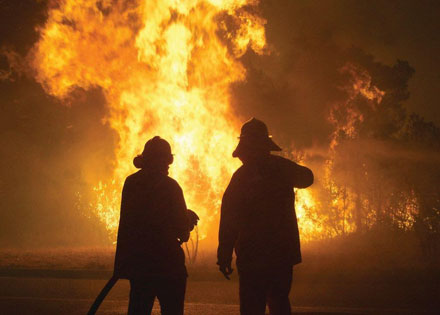
Fire chiefs are warning Victorian communities to prepare for a potentially deadly fire season, amid fears a looming La Nina pattern could lead to residents becoming complacent. Source: The Weekly Times
The Bureau of Meteorology has announced it is on watch for the development of a La Nina pattern this summer, which typically brings rain. However, deputy chief fire officer at the Department of Environment, Land, Water and Planning, Darrin McKenzie, said residents should not interpret a La Nina pattern as a sign the fire season will be a mild one.
“The thing about the La Nina is that it’s very weak and it’s formed quite late in the season,” he said.
“People shouldn’t expect that a lot of La Nina rain will change the fire season.
“Remember, too, that in 2009 (Black Saturday) fires there was a La Nina pattern in place.”
Back then, the season started early in Gippsland with fire coming close to Buchan, north of Lakes Entrance, in September.
“It was 8000 hectares in size and we were seeing fire behaviour that was more typical of fires in January rather than September,” Mr McKenzie said.
Richard Thornton, chief executive of Bushfire and Natural Hazards Cooperative Research Centre, agreed that a La Nina pattern was not a game-changer.
“The winter dried out the subsoils and a large dumping of rain won’t correct that,” he said.
Mr Thornton said while in previous years fire chiefs were concerned about grassland fire threats in southern Australia, this year they had detected an “above-normal” risk for forest areas of southeast and southwest parts of Australia.
“Forest fires are more intense even though they don’t move as quickly,” Mr Thornton said. “But, of course, this is not to say that grassfires aren’t a potential threat.”
Mr McKenzie said he was most concerned about the Gippsland region, particularly the west and southern areas, as well as Victoria’s central corridor running from Macedon through to Bendigo and up to Echuca.
“There is some underlying dryness in these areas, particularly Gippsland,” Mr McKenzie said. “The soil is quite dry and the fuel is quite dry, and there is some indication that we will have elevated temperatures as well.”
The weather system that makes most fire chiefs nervous is the typical Victorian pattern of dry heat followed by a quick and cool change.
“Concentrated air masses in central Australia draw hot winds across to Victoria and we get those days of dry heat and northerly winds,” Mr McKenzie said.
“Then we get a south-westerly change coming through and that is a dangerous time in terms of the fire.
“Once the wind changes, the flank of the fire becomes the head of the fire and these flanks are sometimes 60km in length. That’s typically when you see the loss of life and property.”
This year, DELWP has 49 aircraft on hand with aerial monitoring and water bombing capabilities, including two large air tankers. An additional 645 project firefighters have been brought on to help with fire season, on top of the 300 or so on staff year around.
Mr McKenzie urged residents to take note of fire restrictions as they start to come into play across Victoria.
“Keep an eye on camp fires and don’t leave them unattended,” he said. “And be careful when you mow or use a chainsaw as these things can start fires. Ask yourself if this is the best day to do it.”
Mr Thornton was similarly concerned about complacency. A Hazard Note produced two years ago by the Bushfire and Natural Hazards CRC revealed most people weren’t planning properly.
The Hazard Note — based on seven post-bushfire interview studies conducted in Victoria, Western Australia, Tasmania and NSW from 2009-2014 — found only 5% of the 1760 people interviewed had a written-down bushfire survival plan. Very few people (2%) evacuated early on the basis of fire danger weather predictions, while “few of those interviewed had participated in organised community bushfire safety activities”.
“The written-down plan is really important not because you’re going to sit down and read a plan during a fire, but the process requires you to ensure you think about what you will do, and discuss it with your friends and neighbours,” Mr Thornton said.
“It’s also important to have a plan B and a plan C.
“People make a set of assumptions, such as how many people will be with them on the day and whether the pump is working.
“That means they can be in trouble on a fire day if things don’t go to plan.”





